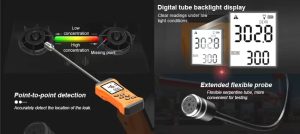Indoor air quality (IAQ) is a critical factor that significantly impacts human health, comfort, and productivity. Poor IAQ, characterized by the presence of pollutants and contaminants, can lead to various respiratory diseases, allergies, and other health issues. To address this concern, innovative gas sensor technologies are emerging as powerful tools to monitor and improve IAQ. In this article, we will explore the significance of gas sensors in enhancing indoor air quality, discuss their working principles, and examine the potential benefits they offer in creating healthier and more sustainable indoor environments.

- Understanding Gas Sensors: Gas sensors are devices designed to detect and measure the concentration of specific gases present in the surrounding environment. They utilize various sensing technologies, such as electrochemical, semiconductor, and optical sensors, to capture and analyze gas molecules. Gas sensors can detect a wide range of gases, including carbon dioxide (CO2), carbon monoxide (CO), volatile organic compounds (VOCs), nitrogen dioxide (NO2), and ozone (O3), which are commonly found indoors and can pose health risks if present in high concentrations.
- Importance of Gas Sensors in Indoor Air Quality: 2.1 Monitoring Air Pollutants: Gas sensors play a crucial role in monitoring and detecting air pollutants within indoor environments. By continuously measuring the concentration levels of gases like CO2, CO, VOCs, and others, these sensors provide real-time data on IAQ. This data enables occupants and building management systems to take timely actions to improve ventilation, reduce pollutant sources, and create healthier indoor environments.
2.2 Early Detection of Hazardous Gases: Certain gases, such as CO and NO2, are known as silent killers due to their odorless and colorless nature. Gas sensors equipped with alarms and warning systems can detect hazardous gas leaks or abnormal concentrations, alerting occupants to evacuate or seek immediate assistance. Early detection and prompt response to these gases can save lives and prevent accidents.
2.3 Energy Efficiency and Ventilation Control: Gas sensors are essential components of smart building systems that optimize energy consumption and ventilation control. By monitoring CO2 levels, these sensors can provide feedback to ventilation systems, ensuring the right amount of fresh air is supplied based on occupancy and IAQ requirements. This dynamic control enhances energy efficiency by reducing unnecessary ventilation and improves occupant comfort.
2.4 Identification of Indoor Pollution Sources: Gas sensors help identify specific sources of indoor pollution by detecting the presence and levels of VOCs. These compounds, commonly emitted by building materials, furniture, cleaning products, and even human activities, contribute to poor IAQ. By pinpointing the sources, necessary actions can be taken to mitigate or eliminate the pollutants, reducing health risks and creating a healthier indoor environment.
- Gas Sensor Innovations for IAQ Enhancement: 3.1 Miniaturization and Portability: Advancements in gas sensor technologies have led to the development of smaller, portable sensors that can be deployed in various indoor spaces. These compact sensors allow for flexible and widespread deployment, enabling comprehensive IAQ monitoring in homes, offices, schools, hospitals, and other indoor environments.
3.2 Wireless Connectivity and IoT Integration: Gas sensors are increasingly being integrated into wireless networks and Internet of Things (IoT) platforms. This connectivity enables real-time data transmission and remote monitoring of IAQ parameters. Building managers and occupants can access the data through mobile apps or web interfaces, empowering them to make informed decisions and take immediate actions to improve IAQ.
3.3 Selectivity and Sensitivity Improvements: Gas sensors are continuously improving in terms of selectivity and sensitivity. Advanced sensor materials and designs allow for accurate and reliable detection of specific gases, even at low concentrations. This selectivity ensures that false alarms are minimized while providing precise data for effective IAQ management.
3.4 Data Analytics and AI Integration: Integration of gas sensors with data analytics and artificial intelligence (AI) algorithms enables advanced IAQ analysis and prediction. By leveraging historical data, environmental parameters, and occupancy patterns, these systems can identify trends, predict pollutant sources, and recommend optimal strategies to maintain healthy indoor environments.
- Benefits of Gas Sensor Innovations for IAQ Enhancement: 4.1 Health and Well-being: Gas sensor technologies contribute to improved IAQ, reducing the risk of respiratory diseases, allergies, and other health issues caused by indoor pollutants. By providing real-time monitoring and early warning systems, these sensors help create healthier indoor environments that promote occupant well-being and productivity.
4.2 Energy Efficiency and Sustainability: Optimizing ventilation based on real-time IAQ data leads to reduced energy consumption and lower carbon emissions. Gas sensors enable smarter HVAC systems that provide fresh air when necessary, minimizing energy waste and supporting sustainable building practices.
4.3 Cost Savings and Maintenance: Early detection of gas leaks and abnormal concentrations helps prevent accidents, property damage, and costly repairs. Gas sensors facilitate proactive maintenance by alerting occupants and building management to potential issues, enabling timely interventions and reducing long-term maintenance costs.
4.4 Regulatory Compliance: Many countries and regions have established IAQ standards and regulations to ensure occupant health and safety. Gas sensors play a crucial role in meeting these requirements by providing accurate and reliable data for compliance monitoring and reporting.
- Future Prospects and Challenges: As gas sensor technologies continue to evolve, several challenges and opportunities lie ahead. Improving sensor accuracy, selectivity, and durability remains a priority to ensure reliable and long-term monitoring capabilities. Additionally, addressing calibration issues, reducing false alarms, and integrating multiple sensors for comprehensive IAQ analysis are areas that require further research and development.
Furthermore, raising awareness about the importance of IAQ and promoting the adoption of gas sensor technologies in both residential and commercial settings are crucial steps towards healthier indoor environments. Collaboration among researchers, manufacturers, building professionals, and policymakers is essential to accelerate the development and deployment of innovative gas sensor solutions.

Conclusion: Gas sensor innovations are revolutionizing IAQ management by providing accurate and real-time data on indoor air pollutants. By monitoring and detecting gases such as CO2, CO, VOCs, and others, these sensors enable proactive measures to improve ventilation, identify pollution sources, and create healthier indoor environments. With advancements in miniaturization, wireless connectivity, selectivity, and AI integration, gas sensors offer tremendous potential for enhancing IAQ, promoting energy efficiency, and ensuring occupant health and well-being. Embracing these technologies and incorporating them into building design and management practices will pave the way for sustainable, healthy indoor environments in the future.
 : +86 155 8830 2704
: +86 155 8830 2704 : jxdziot@gmail.com
: jxdziot@gmail.com
